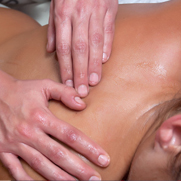Massage Therapy
Massage therapy is an excellent treatment option as a natural conservative option. It is a way to relieve musculoskeletal pain and stiffness for many patients. Our office offers specific muscular and massage therapy that is tailored to meet the patient's injury and condition. Some of the benefits of massage therapy may include: reducing swelling, relieving muscle spasms and muscle pain, increasing blood circulation, relaxing muscles, increasing your range of motion and aid in recovery.
Massage Therapy
Massage therapists take training to use smooth, long, kneading strokes and a variety of other movements based on manipulating the superficial layers of muscle. They use lotion or massage oil to allow easy rubbing of the muscles and to facilitate relaxation while releasing toxins and working out knots within the muscle tissue.
How Does Massage Therapy Work?
Massage therapy relieves pain, and muscle tension by improving circulation. This improved circulation brings nutrients and oxygen to the body tissues. Massage therapy additionally increases mobility and flexibility. It helps clear waste such as lactic acid, thus reducing stiffness and pain in joints and muscles.
Why Do People Get Massage Therapy?
People undergo massage therapy for a variety of health reasons and for relaxation purposes. Some of these conditions include: Migraines and headaches, back pain, stress-related conditions and stress-relief, respiratory and circulatory issues, carpal tunnel and other repetitive strain injuries, tendinitis, arthritis, and other inflammatory conditions. As well, it can be extremely beneficial for post-surgical and post injury healing.
A great massage can leave you feeling invigorated and relaxed. Massage therapy greatly relieves stress. It is reputed to help lower levels of hormones such as cortisol and thus help lower the body's stress response. Massage therapy seems to enhance immune function as well.
What is a Typical Massage Therapy Session is Like?
The majority of massage therapy sessions lasts approximately a half hour to 90 minutes, although, many massage therapists offer customized sessions ranging from 45 min to an hour or longer. Your massage will begin with a brief review of symptoms and consultation discussing your medical history, lifestyle and current symptoms. Many offices will have a paperwork disclaimer for you to sign prior to starting. There is often a diagram of a front visual and a rear visual of the human body for you to put "x's" on where you are sore, feeling pain or discomfort.
Once you are in the therapy room, you will be asked to undress, although, many people choose to keep their underwear on. The massage therapist will wait outside of the room until you are ready. You can lie face down on the padded massage table and cover yourself with the sheet or blanket.
After a few minutes, the massage therapist will knock on the door to make sure you are ready. They will then re-enter the room and will adjust the pillows and the face rest to make sure that you are properly and comfortably positioned. Be sure to mention if you are feeling too cold or warm and the massage therapist will respond accordingly.
The massage therapist generally uses a light lotion or oil on their hands and then starts the massage. A full body massage typically begins on the back and then moves down to the legs. You will be asked to turn over so you are face up after some time. The massage will continue on your legs, arms, abdomen, neck and shoulders.
During the massage, you will be covered with a sheet at all times. In North America, only the part that is being treated at a particular time is uncovered. Once the massage is complete, the massage therapist will exit the room so that you can get changed in privacy. Be sure to take your time getting up and sit up slowly. Some people experience dizziness or feel lightheaded if they stand up or sit up too fast.
Will Massage Therapy Hurt?
There may be a mild aching or discomfort when the massage therapist works on areas of muscle tension and applies pressure over "knots," however, massage therapy should not hurt. If you feel that the pressure is too strong for you, be sure to mention it to the massage therapist and they will adjust their pressure.
How Will I Feel After a Massage?
The majority of folks feel relaxed and calm after a treatment. It is common for some people to feel a temporary aching the next day or two, similar to having gone to the gym or been skiing, depending on how deep the muscle massage was.
Precautions
There are certain people for whom massage therapy is not recommended for: Those who have just had surgery; People with open wounds, rashes or infections skin disease; unless recommended by your doctor, it is not generally done immediately after radiation or chemotherapy; People suffering from heart disease need to check with their doctor prior to booking a massage; People who are prone to blood clots usually do not undergo massage therapy due to the risk of the blood clots being dislodged. As well, it is recommended that pregnant women should check with their doctor first and the massage should be done by massage therapists who are certified in pregnancy massage.
Massage should not be done over an abdominal hernia, areas with bruising, tumors, inflamed skin, areas of recent fractures and unhealed wounds.
Additional Massage Tips
If it your first time at the spa or clinic, try to arrive at least ten minutes early in order to complete the necessary forms. If you get massages on a regular basis, try to arrive five minutes early so you can have a few moments to relax and rest prior to starting the massage. Also, do not eat a large meal before the massage.
![]() Click
to Download the pdf
Click
to Download the pdf





 Home
Home


